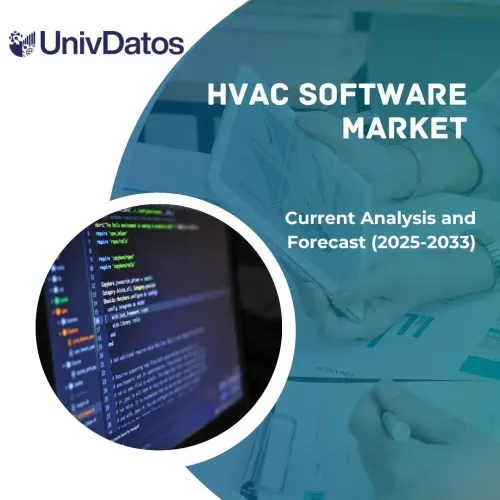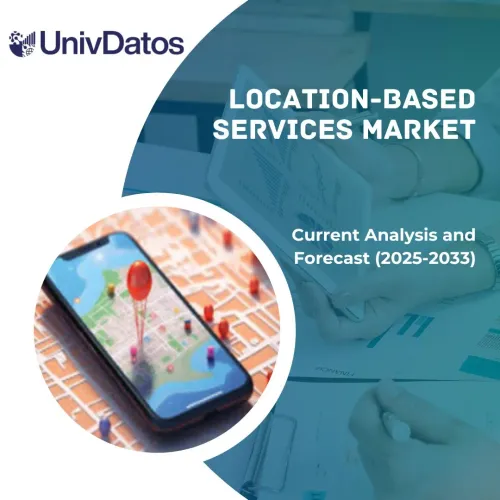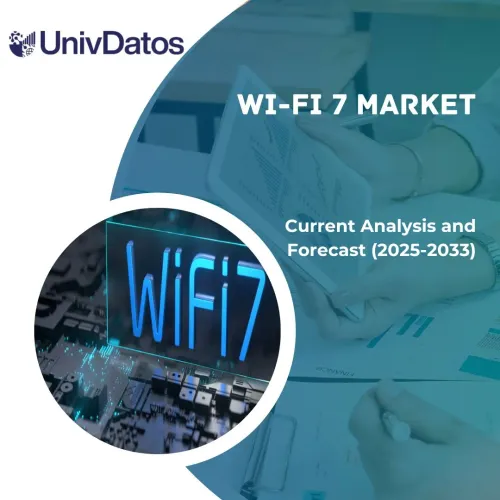- Home
- About Us
- Industry
- Services
- Reading
- Contact Us
Online Language Learning Platform Market: Current Analysis and Forecast (2022-2028)
Emphasis on Learning mode (self-learning apps, applications and tutoring); End-Users (individual and institutional learners) and Age-Group (>18 years, 18-20 years and <20 years) and Region/Country
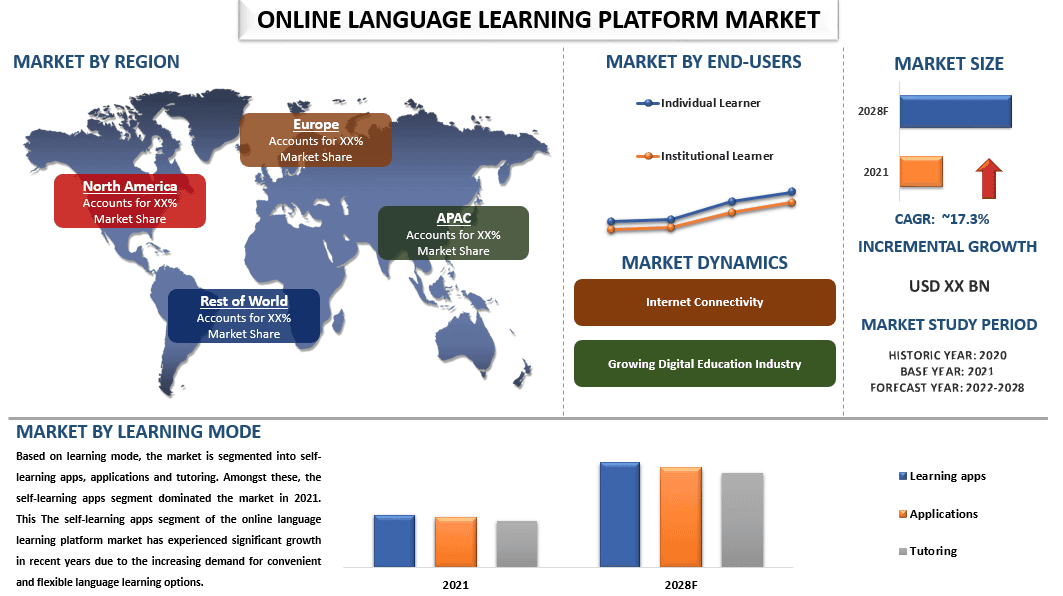
The Online Language Learning Platform Market is expected to grow at a strong CAGR of 17.29% during the forecast period owing to the increasing online resources and cost-effective learning. Moreover, with the increasing competition in various fields people are opting to online platforms instead of attending class offline. Furthermore, many digital education platforms offer interactive features like video lectures, quizzes, and online discussion forums. These features can help learners to stay engaged and motivated throughout their course. Online language learning platforms make it possible for people to learn a new language from anywhere in the world, as long as they have an internet connection. This means that even those living in remote areas or with limited access to traditional language schools can still learn a new language. For instance, based on my findings, more than half (55.8%) of rural Indian students surveyed expressed positive views towards online learning. A minority of students (9.3%) rated online education as excellent, while 10.9% of students deemed the variety of online learning options to be lacking. Additionally, 24% of students perceived the quality of online education to be average.
Some of the major players operating in the market include Cengage Learning India Pvt. Ltd.; Babbel GmbH; Benesse Holdings Inc.; Busuu Ltd.; Duolingo Inc.; Educational Testing Service; EF Education First Ltd.; Enux Education Ltd.; Houghton Mifflin Harcourt Co.; Inlingua International Ltd.
Insights Presented in the Report
“Amongst learning mode, the self-learning apps segment held a dominating share of the market in 2021”
Based on learning mode, the market is segmented into self-learning apps, applications and tutoring. Amongst these, the self-learning apps segment dominated the market in 2021. The self-learning apps segment held a dominating share of the market because of several reasons. Firstly, self-learning apps offer the convenience of learning at one’s own pace and time, without the need for a physical classroom or teacher. This flexibility has been particularly appealing to students and learners who have busy schedules or prefer to learn independently. Secondly, self-learning apps often come with interactive features such as gamification, quizzes, and assessments that make learning more engaging and enjoyable. This can enhance motivation and retention among learners, leading to better learning outcomes. Moreover, self-learning apps can be accessed from anywhere with an internet connection, making them accessible to a wider audience, including those in remote areas with limited access to traditional educational resources.
“Amongst end-users, the individual learners held the majority share of the market in 2021”
By end-users, the market is bifurcated into individual and institutional learners. Among these, individual learners captured the majority share of the online language learning platform market in 2021 With the advent of technology, learning has become more accessible to individuals. Most online learning platforms are affordable, and learners can access the materials anytime, anywhere. With the rapid pace of technological change, individuals need to continuously learn to keep up with the latest developments in their fields. Online learning platforms make it easier for individuals to upskill and stay relevant in their professions.
“Asia Pacific dominated the online language learning platform market in 2021”
The market is divided into North America, Europe, Asia-Pacific, Latin America, and the Middle East & Africa according to geographical location. Asia-Pacific is expected to have the highest compound annual growth rate (CAGR) during the projected period. The region’s rapid expansion is due to the government’s increasing emphasis on the education sector, the widespread adoption of digital technologies in educational institutions, and high investment in education. Furthermore, the online language learning market is growing rapidly due to the region’s developing economies, initiatives aimed at promoting digitization in education, and rising disposable income that encourages internet usage.
Online language learning platform Market Report Coverage
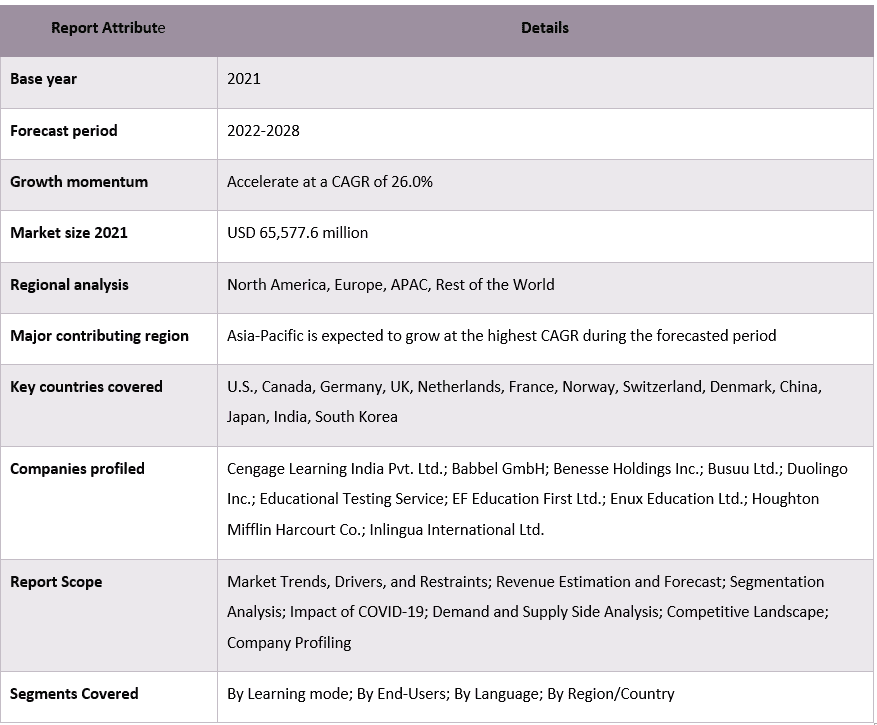
Reasons to buy this report:
- The study includes market sizing and forecasting analysis validated by authenticated key industry experts.
- The report presents a quick review of overall industry performance at one glance.
- The report covers an in-depth analysis of prominent industry peers with a primary focus on key business financials, product portfolios, expansion strategies, and recent developments.
- Detailed examination of drivers, restraints, key trends, and opportunities prevailing in the industry.
- The study comprehensively covers the market across different segments.
- Deep dive regional level analysis of the industry.
Customization Options:
The global online language learning platform market can further be customized as per the requirement or any other market segment. Besides this, UMI understands that you may have your own business needs, hence feel free to connect with us to get a report that completely suits your requirements.
Table of Content
Research Methodology for the Online Language Learning Platform Market Analysis (2022-2028)
Analyzing the historical market, estimating the current market, and forecasting the future market of the global online language learning platform market were the three major steps undertaken to create and analyze the adoption of smart home in major regions globally. Exhaustive secondary research was conducted to collect the historical market numbers and estimate the current market size. Secondly, to validate these insights, numerous findings and assumptions were taken into consideration. Moreover, exhaustive primary interviews were also conducted, with industry experts across the value chain of the global smart home market. Post assumption and validation of market numbers through primary interviews, we employed a top-down/bottom-up approach to forecasting the complete market size. Thereafter, market breakdown and data triangulation methods were adopted to estimate and analyze the market size of segments and sub-segments of the industry pertains to. Detailed methodology is explained below:
Analysis of Historical Market Size
Step 1: In-Depth Study of Secondary Sources:
Detail secondary study was conducted to obtain the historical market size of the smart home market through company internal sources such as annual reports & financial statements, performance presentations, press releases, etc., and external sources including journals, news & articles, government publications, competitor publications, sector reports, third-party database, and other credible publications.
Step 2: Market Segmentation:
After obtaining the historical market size of the smart home market, we conducted a detailed secondary analysis to gather historical market insights and share for different segments & sub-segments for major regions. Major segments are included in the report as learning mode, end-users, age group and language. Further country-level analyses were conducted to evaluate the overall adoption of testing models in that region.
Step 3: Factor Analysis:
After acquiring the historical market size of different segments and sub-segments, we conducted a detailed factor analysis to estimate the current market size of the smart home market. Further, we conducted factor analysis using dependent and independent variables such as learning mode, end-users, age group and language of the smart home market. A thorough analysis was conducted for demand and supply-side scenarios considering top partnerships, mergers and acquisitions, business expansion, and product launches in the smart home market sector across the globe.
Current Market Size Estimate & Forecast
Current Market Sizing: Based on actionable insights from the above 3 steps, we arrived at the current market size, key players in the global smart home market, and market shares of the segments. All the required percentage shares split, and market breakdowns were determined using the above-mentioned secondary approach and were verified through primary interviews.
Estimation & Forecasting: For market estimation and forecast, weights were assigned to different factors including drivers & trends, restraints, and opportunities available for the stakeholders. After analyzing these factors, relevant forecasting techniques i.e., the top-down/bottom-up approach were applied to arrive at the market forecast for 2028 for different segments and sub-segments across the major markets globally. The research methodology adopted to estimate the market size encompasses:
- The industry’s market size, in terms of revenue (USD) and the adoption rate of the smart home market across the major markets domestically
- All percentage shares, splits, and breakdowns of market segments and sub-segments
- Key players in the global smart home market in terms of products offered. Also, the growth strategies adopted by these players to compete in the fast-growing market
Market Size and Share Validation
Primary Research: In-depth interviews were conducted with the Key Opinion Leaders (KOLs) including Top Level Executives (CXO/VPs, Sales Head, Marketing Head, Operational Head, Regional Head, Country Head, etc.) across major regions. Primary research findings were then summarized, and statistical analysis was performed to prove the stated hypothesis. Inputs from primary research were consolidated with secondary findings, hence turning information into actionable insights.
Split of Primary Participants in Different Regions
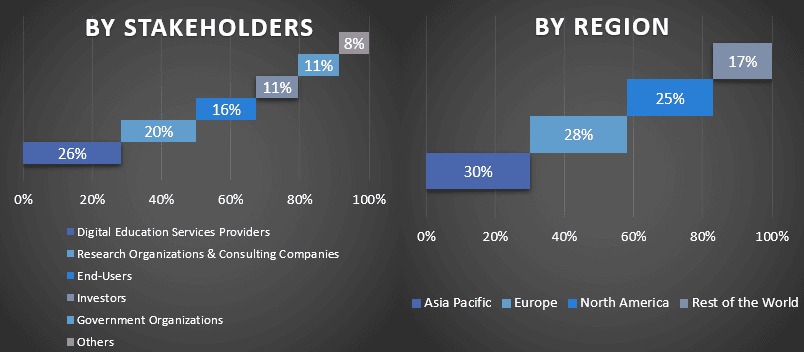
Market Engineering
The data triangulation technique was employed to complete the overall market estimation and to arrive at precise statistical numbers for each segment and sub-segment of the global online language learning platform market. data was split into several segments & sub-segments post studying various parameters and trends in the areas of the learning mode, end-users, age group and language in the global online language learning platform market.
The main objective of the Global Online language learning platform Market Study
The current & future market trends of the global online language learning platform market were pinpointed in the study. Investors can gain strategic insights to base their discretion for investments on the qualitative and quantitative analysis performed in the study. Current and future market trends determined the overall attractiveness of the market at a regional level, providing a platform for the industrial participant to exploit the untapped market to benefit from a first-mover advantage. Other quantitative goals of the studies include:
- Analyze the current and forecast market size of the smart home market in terms of value (USD). Also, analyze the current and forecast market size of different segments and sub-segments
- Segments in the study include areas of the learning mode, end-users, age group and language
- Define and analysis of the regulatory framework for the smart home industry
- Analyze the value chain involved with the presence of various intermediaries, along with analyzing customer and competitor behaviors of the industry
- Analyze the current and forecast market size of the smart home market for the major region
- Major countries of regions studied in the report include Asia Pacific, Europe, North America, and the Rest of the World
- Company profiles of the smart home market and the growth strategies adopted by the market players to sustain in the fast-growing market
- Deep dive regional level analysis of the industry
Related Reports
Customers who bought this item also bought

